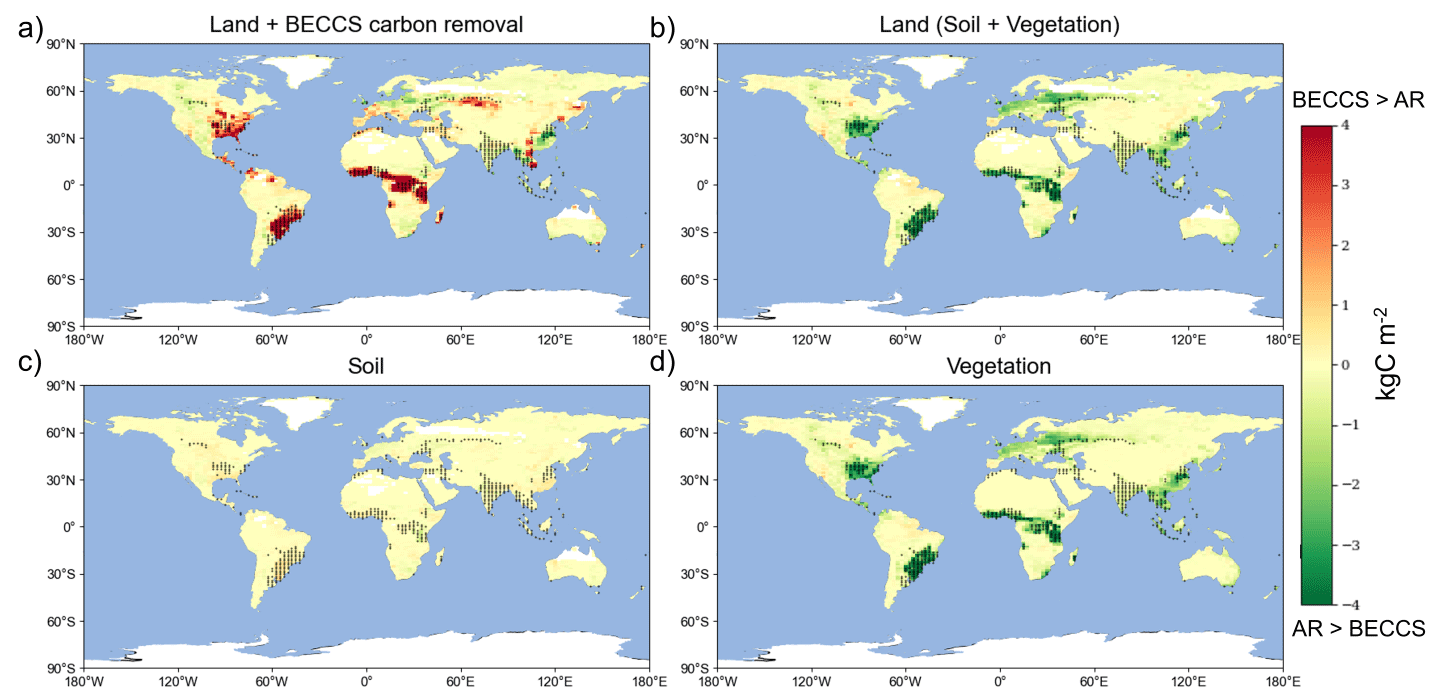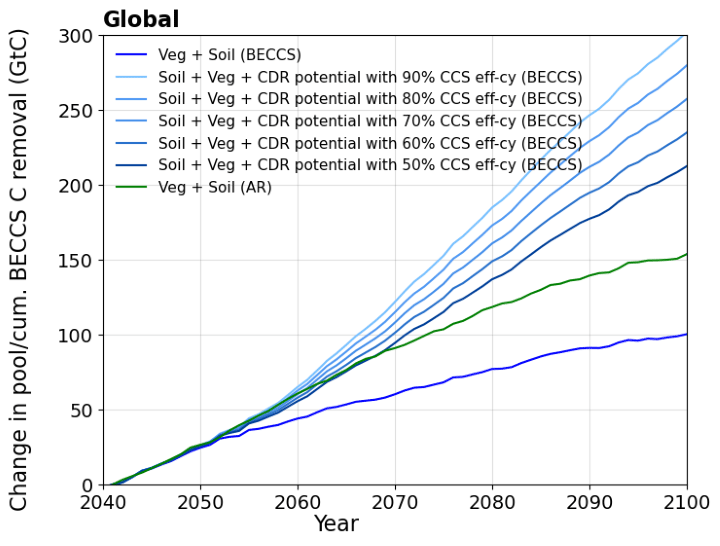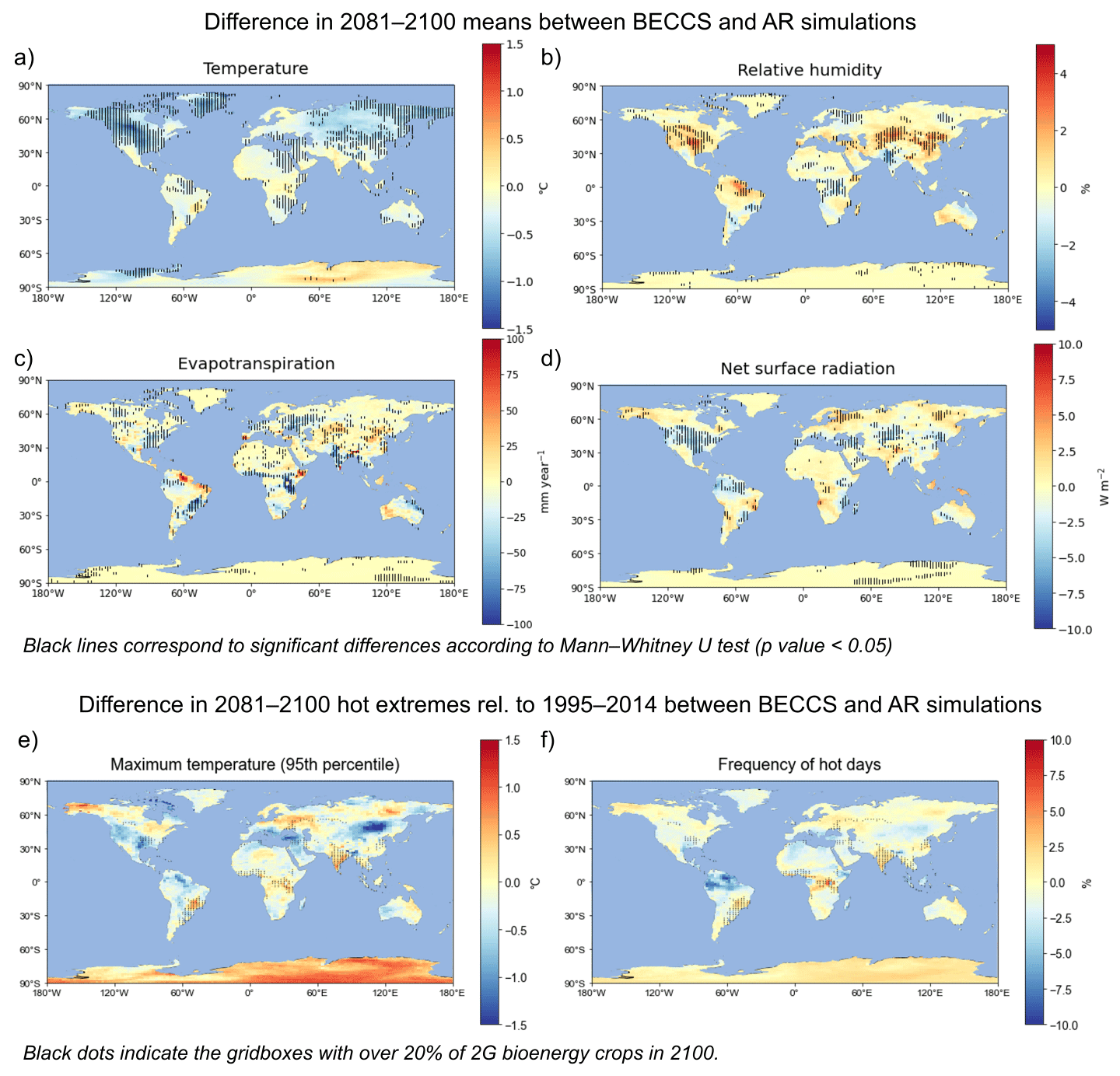Recent Research Results Exploring the regional potentials of forests and bioenergy crops for climate mitigation
The bioenergy with carbon capture and storage (BECCS) and afforestation and reforestation are two most-often considered land-based mitigation options that remove carbon dioxide from the atmosphere. BECCS involves extracting bioenergy from biomass cultivated in dedicated bioenergy crops, then capturing carbon, and storing it to decrease the atmospheric CO2 concentration. Recent studies have assumed large-scale BECCS deployment as a means to achieve the climate targets outlined in the Paris Agreement. However, the widespread adoption of bioenergy crops presents challenges, such as large water and fertilizer demands, concerns over environmental sustainability, technical feasibility, and socio-economic implications. An alternative carbon removal method is afforestation and reforestation, which not only offers co-benefits for human well-being but also receives broad societal support. AR benefits also include enhanced biodiversity, improved air and water quality, soil conservation and creation of green spaces that promote recreational activities.
We compared the two mitigation options, BECCS and afforestation, using state-of-the-art earth system model simulations. We explored a future scenario involving large-scale deployment of bioenergy crops and an alternative scenario with afforestation in the same target areas from year the 2040 to 2100. In the considered overshoot scenario, high emissions before 2040 result in a 21st century overshoot of the 2°C Paris Agreement target. Both mitigation options (with their distributions shown as dotted areas in Figure 1) lead to the eventual decrease of atmospheric CO2 concentration and surface temperatures.

While BECCS has a greater potential for removing carbon than afforestation globally, it's important to consider regional factors. In some parts of Europe and East Asia, the carbon emissions from changing land use for bioenergy crops might outweigh the benefits of BECCS (see Figure 1a).
Further, bioenergy crops and forests differ in their responses to the changes in atmospheric carbon concentration and surface temperatures. Forests store more biomass and can absorb more carbon through photosynthesis (see Figure 1 b-d). However, they are also more vulnerable to carbon losses in a warmer climate through the impacts of pests, droughts, or fires. Thus, while forests have significant carbon removal potential, it's important to consider their future resilience and vulnerability to climate change when deciding whether to prioritize bioenergy crops or forests.
BECCS shows long-term carbon removal benefits, but afforestation has the potential to deliver comparable or even greater benefits than BECCS in the short, 20-30 years, term (Figure 2). This is important to consider because many countries have their carbon neutrality goals by 2050s-2070s. Implementation improvements, such as timber harvesting for bio-based materials, may further increase long-term carbon removal benefits of afforestation, although under condition that the materials are kept long enough. Besides, the effectiveness of BECCS in removing carbon depends on how much carbon from bioenergy crops can be permanently stored, which is currently mostly theoretical (see different shades of blue in Figure 2).

Finally, bioenergy crops and forests have distinct climate effects due to their different interactions with the environment (Figure 3). Bioenergy crops reflect more sunlight (higher albedo) compared to forests, leading to local cooling, and supporting the feasibility of BECCS in many regions of the northern high- and mid-latitudes, considered in the study. However, in Europe, the implementation of BECCS might contribute to an increase in extreme heats (Figure 3 e, f). On the contrary, plant evaporation effects in forests can bring local cooling and make afforestation favorable in tropical and subtropical regions of the Southern Hemisphere.
Our study stresses the importance of conducting more studies at local and national scales to understand carbon removal methods in more detail and evaluate their impacts on biodiversity, ecosystem services, environmental sustainability, and water scarcity. We provide insights into diverse strategies for effective climate action and highlight the importance of considering region-specific factors when evaluating the potential of afforestation and reforestation and BECCS as carbon removal solutions.

Differences in (a) surface air temperature (°C), (b) relative humidity (%), (c) surface evapotranspiration (mm year-1), and (d) net surface radiation (W m-2) averaged over 2081–2100 between the BECCS and AR experiments. Black vertical lines correspond to the grids with a significant difference (p-value <0.05) according to the Mann-Whitney U test. Differences in (e) daily maximum surface air temperature at 95th percentile (°C) and (f) frequencies of days with maximum temperature above 95th percentile (%) estimated in 2081–2100 rel. to 95th percentile of 1995–2014 baseline in BECCS and AR experiments. Black dots indicate the grids with over 20% of second-generation bioenergy crops in 2100. Positive values indicate larger values in the BECCS than in the AR experiment.
Relative benefits of allocating land to bioenergy crops and forests vary by region
Author: Melnikova, I., Ciais, P., Tanaka, K., Vuichard, N., & Boucher, O.
Journal: Commun Earth Environ 4, 230 (2023)
https://doi.org/10.1038/s43247-023-00866-7

